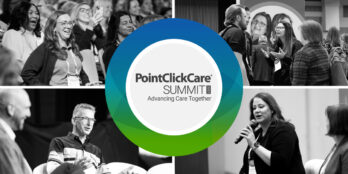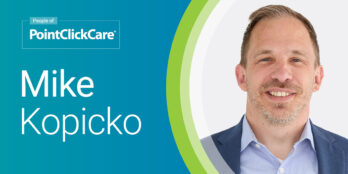
Heard from the C-Suite: Top 3 Senior Living Challenges
 4 min
4 min
Senior housing can be tough. Whatever your role is in providing care and housing for the aging demographic, there are challenges along the way. Rising acuity? Check. More demanding residents? Check. Doing more, with less? Check, check.
For the highest level of upper management in senior housing, the challenges are also real. Three of those leaders recently weighed in on their challenges during a panel discussion hosted by Senior Housing News in Washington D.C. Here’s what they’re seeing as the top challenges today.
Challenge #1: Much ado about data
We live in the information age; we get it. Through the latest technologies, we can gather and track data that should, in theory, be really helpful not only in positioning senior housing as a healthcare partner, but also in improving the customized care approach for all residents.
But where to begin collecting that data? It’s a challenge that even the top executives struggle with.
“I think our biggest challenge is deciding what data we need to collect,” says Brenda Bacon, president and CEO of Brandywine Living, based in Mt. Laurel, New Jersey, “…what’s the use of the data? What’s it for? Sometimes I think we get caught up in just collecting data to be collecting data, just because it’s there. When we sit and talk to healthcare systems, it’s interesting to see the data that they’re looking for as opposed to the data that we typically think about when we think about a person’s clinical record.”
Senior living providers stand to gain by listening to their care partners and focusing in on the data that matters most to them. Data doesn’t have to be overwhelming, but a plan of action around data collection can make all the difference.
Challenge #2: Education, education, education
Most people who work in senior living know that setting expectations and educating prospective residents and their family members is paramount. It’s important to inform residents and their families about the role senior living plays from daily care needs to meal plans, medication management, and more. It’s also important to make sure that education takes place upfront so that expectations can be managed accordingly. Luckily, with the help of technology, it’s easy to demonstrate to those family members that the resident’s needs are being met.
“We have this huge issue about how we educate the consumer about what [the] end of life experience is,” says Pat Mulloy, CEO of Louisville, Kentucky-based Elmcroft Senior Living. “There’s no doubt about it, a resident today is a lot more frail than when I came into the business in 1996…we are all raising standards of care, but [we need to educate] the consumer that this is what happens in [our] business.”
But there’s more education that needs to be done when it comes to senior living, and CEOs are taking an interest in this effort: educating the future workforce.
“There’s one other challenge to this in educating the consumers…there are going to be a lot of new entrants into our business, a lot of people who have never been in this business before who think it’s easy,” Bacon says. “Yes, we all have service failures, it’s part of the game. But if you’ve got somebody coming into the industry who’s never done it before and really is not taking the precautions we take and paying the attention to quality that we are, they provide a huge risk to us.”
Challenge #3: The future workforce
Staffing and recruiting senior care workers is a challenge for leadership, especially in an era of very low unemployment. Because of such low unemployment across many industries, senior housing providers are competing against retail and food service employers to attract workers.
CEOs point to competitors such as quick serve restaurants and Starbucks, which have not historically been vying for the same workers, and offer some perks relative to the tasks involved in housing and caring for senior residents.
“It’s difficult work,” Mulloy says. “It’s not nearly as easy as pulling donuts off of a shelf or pouring coffee for a consumer. It’s probably more engaging; it’s more meaningful, and it’s got that going for it, but there’s still this whole question of: How [do] you find folks right now?”
Providers need to view the hiring process like the sales process, and technology can be an aid in recruitment and retention.
In the hiring process, providers will be well-served to mention the technologies they use, the ways in which they help staff do their jobs, and the efficiencies they create. It can be all the difference between working in senior housing versus working at Starbucks, where those types of technologies don’t exist.
“I think the entire industry is behind in this area: we’ve been so focused on selling that next grandmother and that next adult daughter…we’ve got to be just as vigilant at bringing the same sales efforts to hiring our employees and recruiting those employees,” Mulloy said.
There are challenges for today’s senior living management, to be sure. But technology can help to address at least some of these challenges and to propel senior living businesses into the future.
Hear from other senior living executives, and how they’re tackling some of their biggest obstacles and opportunities, by checking out The Leadership Series.
June 5, 2017






